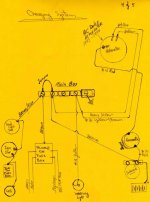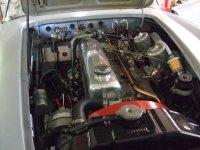Offline
I know that many in the LBC hobby like using relays whenever possible and I know that many times it is not only a good idea but it is necessary. To me whether you use relays or not is not the main issue. The main issue to me is where you pull the main power from on our Healeys especially as well as most LBCs. As Ray mentions old wiring harnesses can be risky to add additional current to. But you have to get the current from some where whether you run it to a relay or directly to the load device. In my Healey I have a completely new harness, I also have two fuse boxes that each have 8 or 10 positions. The one box is off the ignition switch and is the replacement for the one original 35 amp fuse. This box really only has the same load devices on it that the original 35 amp fuse had, it just allows me to have separate fuses. So in this case the ignition switch is not carrying any more current than originally designed but I did substitute a larger wire between the ignition switch and this fuse box. I call this box the "Ignition On Fuse Box" because it only comes on with the ignition switch. The second fuse box I have is there because it substitutes for the original 50 amp fuse. And it too only has circuits on it that were originally intended for the 50a fuse. Such as the horns & driving lights. I have no radio but if i wanted one it would be tied into this second fuse box. I call this fuse box the "Always On" fuse box because like the original 50 fuse it is always hot, even with the key off. So because I have a new harness and I have no more load in my car than it was originally designed for I feel very confident in supplying this fuse box with the original wire that fed the original 50a fuse. But in truth I did change this wire to one size larger because it literally just comes direct from the voltage regulator. So my driving/fog lights are fed from this 2nd fuse box. When I installed the alternator I also removed the voltage regulator. In its place I installed a terminal strip to give me terminals to complete the circuits which were originally at the voltage regulator. I call this my "Main Bus" because it is the central point of all the power in the car. Since both my fuse boxes are fed from this "Main Bus" they literally have a direct path to the battery and the alternator. So my whole point in this dissertation is no matter whether you use a relay to switch the 10 amps for the driving lights or you use a 20a toggle switch the most important connection is the connection you make to your power source. As Ray has high lighted you don't want to connect to something that causes you to overload your harness. Remember the car was designed for driving lights so a good harness should be able to handle the additional power requirement. But maybe a 60 year old harness can't. I would recommend that you create a "main bus" or a tap dedicated for the driving lights. You could tap it off the battery terminal and the starter solenoid or you could take it off the battery terminal on an alternator. If you don't have an alternator remember that the "A" terminal of the original voltage regulator is powered from the battery terminal on the starter solenoid. If you don't like these 3 locations then remember if you feel your harness is in good shape you can tap power at the 50 amp fuse. If you use one of the 3 previous options remember to install an inline fuse as soon as you make the tap. In the electrical drawing of my car's circuits that I have attached where is shows the Main Bus, the two left had terminals with the jumper across them is representative of the A1 and A terminals on a voltage regulator. You will need one of these power sources whether you use a relay or not. Good Luck.

 Hi Guest!
Hi Guest!

 smilie in place of the real @
smilie in place of the real @
 Pretty Please - add it to our Events forum(s) and add to the calendar! >>
Pretty Please - add it to our Events forum(s) and add to the calendar! >> 


